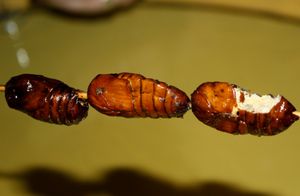The Growing Popularity of Eating Insects

“What’s worse than finding a worm in your apple?” the old joke goes. “Finding half a worm in your apple,” comes the answer. Indeed, seeing an insect in a restaurant is, for many people, a reason to walk out. Finding an insect in one’s food, moreover, can be gag-inducing.
Reactions like these are not typical in every culture. According to research, people in 80% of countries eat 1000-2000 types of insects. The UN Food and Agriculture Organization (FAO) wants to build on those numbers. FAO wants to encourage insect-eating as a response to the rising world population that is forecast to go over 9 billion by 2050. While the demand for food is increasing, there is greater recognition that the farming of food sources like cows, pigs, and sheep, contributes significantly to greenhouse gas emissions.
In Japan, some people have responded to FAO’s encouragement, and the eating of insects is on the rise. Historically, the Japanese have eaten insects, albeit in greater amounts during hard times, like during and after World War Two. Currently, several restaurants in Tokyo are raising the profile of insects as food. Mushi-ya, a stall in Ueno, sells cricket and silkworm skewers. Water bug cider and cricket curry are popular at Take-Noko, a cafe near Asakusa. Rice & Circus has multiple branches that serve dumplings with maggots and bee-larvae sprinkled on top. Antcicada, not far from Akihabara, is known for its cricket ramen.
The founder of Antcicada, Yuta Shinohara, was inspired to activism by FAO reports while still at school. Since then, his passion for insect-eating has lost and gained him friends, and in 2020, he opened the restaurant. Shinohara wants people to know that insects are delicious and high in nutrients. If he has his way, people in Japan and beyond will be opening their eyes to the benefits of eating insects.
Sources: reuters.com, theguardian.com, tokyocheapo.com, mainichi.jp, wikipedia.org
For source links, see the article on ESLNewsStories.com
Audio
Hear the article spoken:
Useful Language
- Gag-inducing (adj) - makes you feel like vomiting
- Agriculture (n) - the practice of farming
- Build on (phr. v) - to use something as a basis
- Forecast (v) - to predict or calculate a future event or condition
- Recognition (n) - learning and accepting that something is true
- Greenhouse gas (n) - a gas that causes global warming
- Emission (n) - a gas that is sent out
- On the rise (prep. phr) - rising
- Albeit (conj) - although
- Profile (n) - the public attention that something gets
- Cricket (n) - an insect that hops and chirps
- Skewer (n) - a long thin piece of wood or metal that goes through food
- Maggot (n) - a small worm that later becomes a fly
- Larvae (n, pl) - small wormlike creatures that later become insects
Discussion
Discuss the following questions with your partner(s).
- What did you think about this story? Was there any surprising information?
- Does your country have a history of eating insects? Are they still eaten today?
- Have you ever found an unexpected insect in your food? How did you react?
- Have you eaten any insects? How were they cooked? How was the taste?
- Some people are scared of insects. Why is this?
- Is insect-eating a good response to the problems of food supply and global warming?
- Is there a food that you hate? If so, what makes you hate it?
- People say that shrimp are similar to insects. Do you like eating shrimp?
- Do you eat meat from animals like cows, sheep, and pigs? How often? Have you considered limiting your eating of them for the environment?
- Would you try the food at any of the places mentioned in the article? Which would you choose?
- Have you been to Tokyo? What do people usually eat when they go there?